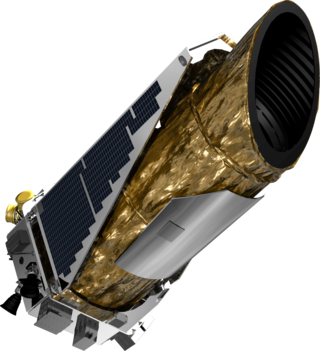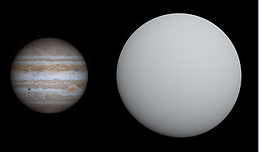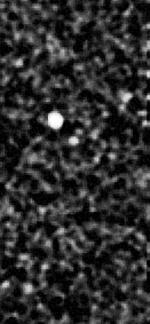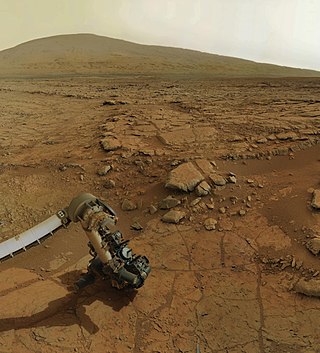
A terrestrial planet, telluric planet, or rocky planet, is a planet that is composed primarily of silicate, rocks or metals. Within the Solar System, the terrestrial planets accepted by the IAU are the inner planets closest to the Sun: Mercury, Venus, Earth and Mars. Among astronomers who use the geophysical definition of a planet, two or three planetary-mass satellites – Earth's Moon, Io, and sometimes Europa – may also be considered terrestrial planets. The large rocky asteroids Pallas and Vesta are sometimes included as well, albeit rarely. The terms "terrestrial planet" and "telluric planet" are derived from Latin words for Earth, as these planets are, in terms of structure, Earth-like. Terrestrial planets are generally studied by geologists, astronomers, and geophysicists.

The Kepler space telescope is a defunct space telescope launched by NASA in 2009 to discover Earth-sized planets orbiting other stars. Named after astronomer Johannes Kepler, the spacecraft was launched into an Earth-trailing heliocentric orbit. The principal investigator was William J. Borucki. After nine and a half years of operation, the telescope's reaction control system fuel was depleted, and NASA announced its retirement on October 30, 2018.

An exoplanet is a planet located outside the Solar System. The first evidence of an exoplanet was noted as early as 1917, but was not recognized as such until 2016; no planet discovery has yet come from that evidence. What turned out to be the first detection of an exoplanet was published among a list of possible candidates in 1988, though not confirmed until 2003. The first confirmed detection came in 1992, with the discovery of terrestrial-mass planets orbiting the pulsar PSR B1257+12. The first confirmation of an exoplanet orbiting a main-sequence star was made in 1995, when a giant planet was found in a four-day orbit around the nearby star 51 Pegasi. Some exoplanets have been imaged directly by telescopes, but the vast majority have been detected through indirect methods, such as the transit method and the radial-velocity method. As of 24 July 2024, there are 7,026 confirmed exoplanets in 4,949 planetary systems, with 1007 systems having more than one planet. This is a list of the most notable discoveries.
A Kepler object of interest (KOI) is a star observed by the Kepler space telescope that is suspected of hosting one or more transiting planets. KOIs come from a master list of 150,000 stars, which itself is generated from the Kepler Input Catalog (KIC). A KOI shows a periodic dimming, indicative of an unseen planet passing between the star and Earth, eclipsing part of the star. However, such an observed dimming is not a guarantee of a transiting planet, because other astronomical objects—such as an eclipsing binary in the background—can mimic a transit signal. For this reason, the majority of KOIs are as yet not confirmed transiting planet systems.

The NASA Exoplanet Archive is an online astronomical exoplanet catalog and data service that collects and serves public data that support the search for and characterization of extra-solar planets (exoplanets) and their host stars. It is part of the Infrared Processing and Analysis Center and is on the campus of the California Institute of Technology (Caltech) in Pasadena, CA. The archive is funded by NASA and was launched in early December 2011 by the NASA Exoplanet Science Institute as part of NASA's Exoplanet Exploration Program. In June 2019, the archive's collection of confirmed exoplanets surpassed 4,000.

Planet Hunters is a citizen science project to find exoplanets using human eyes. It does this by having users analyze data from the NASA Kepler space telescope and the NASA Transiting Exoplanet Survey Satellite. It was launched by a team led by Debra Fischer at Yale University, as part of the Zooniverse project.

Kepler-69c is a confirmed super-Earth exoplanet, likely rocky, orbiting the Sun-like star Kepler-69, the outermore of two such planets discovered by NASA's Kepler spacecraft. It is located about 2,430 light-years from Earth.
Kepler-296e is a confirmed super-Earth exoplanet orbiting within the habitable zone of Kepler-296. The planet was discovered by NASA's Kepler spacecraft using the transit method, in which the dimming effect that a planet causes as it crosses in front of its star is measured. NASA announced the discovery of the exoplanet on 26 February 2014.
Kepler-283 c is an exoplanet orbiting the K-type star Kepler-283 every 93 days in the circumstellar habitable zone, discovered by the Kepler space telescope in 2014.

NGTS-3Ab is a gas giant exoplanet that orbits a G-type star. Its mass is 2.38 Jupiters, it takes 1.7 days to complete one orbit of its star, and is 0.023 AU from its star. Its discovery was announced in 2018. The Jupiter-like planet is discovered by 39 astronomers, mainly Max Günther, Didier Queloz, Edward Gillen, Laetitia Delrez, and Francois Bouchy.

HD 89345 b is a Neptune-like exoplanet that orbits a G-type star. It is also called K2-234b. Its mass is equivalent to 35.7 Earths, it takes 11.8 days to complete one orbit of its star, and is 0.105 AU away from its star. It was discovered by a team of 43 astrophysicists, one of which was V. Van Eylen, and was announced in 2018.
KOI-5 is a triple star system composed of three stars: KOI-5 A, KOI-5 B and KOI-5 C, orbiting 1,870±70 light-years away.
Kepler-289 (PH3) is a rotating variable star slightly more massive than the Sun, with an unknown spectral type, 2370 light-years away from Earth in the constellation of Cygnus. In 2014, three exoplanets were discovered orbiting it.

TOI-2180 b is a giant exoplanet orbiting the G-type star TOI-2180, also known as HD 238894. It was discovered with the help of the Transiting Exoplanet Survey Satellite and is currently the exoplanet with the longest orbital period TESS was able to uncover. TOI-2180 b orbits its host star every 260.16 days.

The habitability of F-type main-sequence starsystems is disputed due to the shorter lifetimes and higher levels of UV radiation. Indeed, F0 stars are considered by many scientists as the hottest and most massive stars capable of supporting habitable planets. A planet orbiting an F-type star at the Earth boundary within the HZ would receive 2.5 to 7.1 times the UV that Earth gets from the sun.
Kepler-385 is an F-type main-sequence star located about 4,900 light-years away from Earth in the constellation of Cygnus. The star is 10% larger and 5% hotter than the Sun. The star has at least three, and potentially up to seven, exoplanets discovered orbiting it.
KOI-5715.01 is an exoplanet candidate that orbits the K-type dwarf star KOI-5715, located approximately 2,964 light-years from Earth in the constellation of Cygnus. It was identified in 2015 through an analysis of light curve data obtained by the Kepler space telescope. While the exoplanet is yet to be confirmed, preliminary data suggests that it is one of the more promising superhabitable planet candidates.













